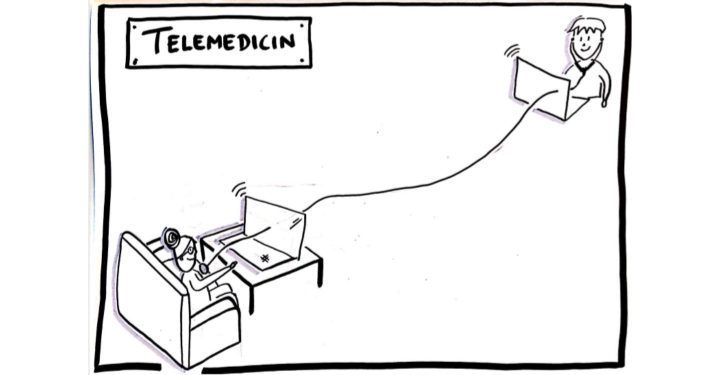If you have experience of using telehealth – either as a clinician or a patient – which you would like to share with us (positive or negative), please send an email to: tatjana.sandreva@patientsikkerhed.dk
The advent of the jet airliner
In 1949 the British aviation firm De Havilland launched the Comet, the world’s first jet airliner. The fast and comfortable plane caught the imagination of the public and was seen as a solution to the problem of very long flights using propeller planes. However, from 1952 to 1954 seven Comets crashed, resulting in the deaths of 110 people. Several of the aircraft disintegrated at high altitude, with no survivors, witnesses, or immediate clues as to what had happened. In 1954 the entire fleet of Comets was permanently grounded, and the most comprehensive air crash investigation ever undertaken began.

Meanwhile, in Australia the Department of Civil Aviation had held a meeting of experts to discuss the possible cause of the crashes. One of these experts was Dr David Warren, who realized that there was simply insufficient data to be able to learn from the crashes or propose changes to reduce the chance of crashes occurring in the future. Indeed, the people best placed to have known what might have caused the crashes were the flight crew who were all dead.
As a result, Warren designed, developed, and helped implement the Flight Data Recorder, also known as the ‘black box’. The device was a game-changer and constituted a reliable system for collecting data to help understand how errors are made, what has led to an accident and what changes might reduce the chance of similar accidents occurring in the future.
The device was a game-changer and
constituted a reliable system
for collecting data to help
understand how errors are made
In the last few weeks, as the reality of the COVID-19 pandemic has hit home to people across the globe, we have seen a proliferation of scientific and healthcare articles dedicated to the subject. Of course, this is right, the scientific and healthcare community must be quick to react and adapt to this new challenge. We noted with interest, an editorial in the British Medical Journal by Professor Trisha Greenhalgh and colleagues (https://www.bmj.com/content/368/bmj.m998) on the subject of video consultation, in which they ask the following question:
“The rapid spread of covid-19, and the fact that healthcare facilities could be sources of contagion, has focused attention on new models of care that avoid face-to-face contact between clinician and patient. There has been particular interest in video consultations, which are already being rolled out in many countries as part of national digital health strategies.1-3 How appropriate are video consultations for dealing with the coronavirus crisis—and what are the challenges of scaling up this model at speed?”
The role of telemedicine in healthcare
Prior to the issue of COVID-19, we (Danish Society for Patient Safety) have been particularly interested in the role of telemedicine (of which video consultation is an example) in Danish healthcare. This is because, Denmark has been promoted as one of the world’s most digitalized countries1 and for the last 15 years the government has worked on joint public sector digital strategies,2 one of which is the deployment of digital health solutions such as telemedicine, to ‘provide freedom and empower individuals’.3 From this perspective, telemedicine is understood as ‘the delivery of health care services using electronic communications and information technologies when participants are at different locations’.4
Even before the current COVID-19 pandemic, telemedicine was seen as a popular solution to meet some of demographic and economic challenges of 21st century healthcare provision; therefore, implementation continued at pace. As a result of the current need to reduce the spread of COVID-19, there is increasing interest and demand for the adoption of telemedicine across the healthcare system to support the safe provision of healthcare across country. As such, it seems appropriate for an organisation such as our, which is devoted to patient safety and quality improvement, to ask a simple question: Over the last few years of telemedicine implementation and use in healthcare, what learning has occurred from reviewing the data relating to telemedicine – including patient safety incidents.
In 2019, we made an initial field analysis to answer this question. This process revealed data indicating a variety of risks and challenges for patients, professionals, and the related authorities. This subsequently inspired us to map telemedicine patient safety related incidents in Denmark. Whilst we acknowledge, that the reporting of patient safety incidents does not necessarily provide the whole picture of the risk and harm associated with telemedicine, we believe it can contribute to learning about clinical sociotechnical interactions to develop safer systems and improve workflows.
The current configuration of the
Patient Safety Database does not provide
a standardized way to report, collect,
nor analyze data regarding telemedicine
Patient safety systems
Like several other countries, Denmark has a national incident reporting and learning system – Danish Patient Safety Database (DPSD) which enables patient safety incidents to be reported by healthcare providers. A modification to the system in 2011 means patients and their families can now also report incidents.5 A ‘patient safety incident’ is an event or circumstance that could have resulted, or did result, in unnecessary harm to a patient.6 Once an event is reported to DPSD, it is analysed locally for learning. At national level, the Danish Patient Safety Authority collects aggregated anonymized data from DPSD for learning and quality improvement. Each year, areas of interest are identified for deeper analysis at a national level. During 2018 almost 200,000 reports of patient safety incidents were administered.
These range from ‘non-significant medicotechnical errors’ to ‘serious harm to a patient’. For each incident, the DPSD contains data fields such as ‘date of incident’, ‘location’, ‘category’ ‘type of incident’ e.g. medication error, and a free-text description of the incident.
Unfortunately, our attempt to collect data regarding telemedicine related patient safety incidents revealed only that the current configuration of DPSD does not provide a standardized way to report, collect, nor analyze data regarding telemedicine. There is simply no category for incidents when the health care is delivered digitally.
We subsequently tried to collect data from the Danish Medicines Agency (DMA) regarding events including medical devices used in telemedicine. By law, any medical device malfunction, failure, or deficiency should be notified to the DMA by healthcare professionals and manufacturers. All reports are subsequently reviewed to determine if the manufacturer should make changes to the device, update the instructions for use or if the device should be removed from the market.7 The current reporting system at DMA has similar limitations to DPSD. As such, it was not possible to extract patient safety incident data regarding medical devices used in telemedicine.
Patients may be exposed to unnecessary harm,
health care workers may inflict
and be held responsible for unnecessary harm,
and the authorities are unable to recognise
potential trends in harm across the system.
Mind the gap
This can only lead us to state that there is currently a gap between the current implementation of telemedicine, and the related modifications to the reporting systems developed to support potential for learning and quality improvement.
Information relevant to all stakeholders is falling through that gap. Consequently, patients may be exposed to unnecessary harm, health care workers may inflict and be held responsible for unnecessary harm, and the authorities are unable to recognise potential trends in harm across the system.
The actions necessary to close this gap, and therefore reduce these potential harms, need not be overwhelming; new categories and reporting processes need to be adapted within the current system. The change to the system in 2011 to allow patients and families to report incidents is an example of how modifications can be made.
As noted in the editorial piece in the BMJ by Trisha Greenhalgh and colleagues:
“…given the many clinical, technical, organisational, and policy questions raised by this promising service model and the natural experiment we are probably about to witness (due to COVID-19), we strongly recommend a research call to ensure that we maximise the lessons learnt”.
Our recommendation is supplementary to this research call. Alongside the testing and implementation of any new technology, there needs to be an equivalent system of identifying, recording, and learning from incidents involving that new technology, i.e. a black box. However, this is not where we find ourselves with telemedicine. If Denmark, or any other country, wants to succeed in the rapid utilization of telemedicine to support care provision during the current pandemic, or indeed as an international leader in digitalization, it will also need to be a world leader in systems to support reporting and learning. We may have a jet airliner, but we still do not have a black box.
Final word:
We are keen to develop a better understanding of the challenges and opportunities of using telehealth across the healthcare system.
If you have experience of using telehealth – either as a clinician or a patient – which you would like to share with us (positive or negative), please send an email to:
tatjana.sandreva@patientsikkerhed.dk
Many thanks, PS!
References:
- European Commission website, The Digital Economy and Society Index (DESI): https://ec.europa.eu/digital-single-market/en/desi (Date accessed: January 30, 2020)
- Danish Agency for Digitisation, Digital Strategy 2016-2020: https://en.digst.dk/policy-and-strategy/digital-strategy/ (Date accessed: January 30, 2020)
- Danish Agency for Digitisation, National dissemination of telemedicine for patients with COPD by the end of 2019: https://en.digst.dk/policy-and-strategy/digital-welfare/telemedicine/ (Date accessed: January 30, 2020)
- Danish National Health Data Authority, Healthcare conceptual framework: https://sundhedsdatastyrelsen.dk/nbs (Date accessed: January 30, 2020)
- Danish Patient Safety Authority, Patient safety incidents: https://stps.dk/da/laering/utilsigtede-haendelser/ (Date accessed: January 30, 2020)
- WHO, Patient Safety: https://www.who.int/news-room/fact-sheets/detail/patient-safety (Date accessed: January 30, 2020)
- Danish Medicines Agency, Reporting of incidents and accidents with medical devices: https://laegemiddelstyrelsen.dk/en/devices/incident-reporting/ (Date accessed: January 30, 2020)
- Sveiby, K-E., Segercrantz, B. U., Gripenberg, P., Eriksson, A., & Aminoff, A. (2009). Unintended and Undesirable consequences of Innovation. In K. R. E. Huizingh, S. Conn, M. Torkkeli, & I. Bitran (Eds.), Proceedings of the XX ISPIM Conference




